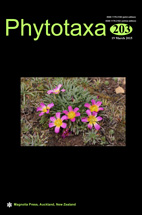Abstract
Calandrinia caespitosa is one of seven species currently recognized in Calandrina sect. Acaules. It has been interpreted by all recent studies to represent a single species with variable flower colours. It is here shown that, on the contrary, this entity is a complex which includes four distinct species. C. caespitosa inhabits depressions at elevations between 2500 and 4000 m in the Andes mountains between 29º S and 36º S. It is morphologically characterized in having 6–8 ellipsoid, flamboyant red petaloids, yellowish-green towards the base. Its typification is discussed, while the synonyms C. diffusa and C. densiflora are neotypified on specimens preserved at K. C. skottsbergii grows in dry, gravelly mountains in central Patagonia from ca. 38–47o S. It has 6–12 petaloids which are truncate and longer and broader than those of C. caespitosa, orange or rarely yellow, and capsules much larger than those of C. caespitosa. A deviating species pair occurs in southern Patagonia: C. fuegiana with white or pinkish petaloids and C. ranunculina with yellow petaloids. The latter species is described in this study as new to science. Both C. fuegiana and C. ranunculina share a rather small, weakly zygomorphic perianth with 2+4 petaloids which open for a short period, and then close to allow for self-pollination when the anthers move towards the stigma. This is interpreted here as an adaptation to the very strong winds prevailing in their habitats. C. fuegiana grows in screes and snow beds in the high mountains from 47º S to near 52o S, in addition to an isolated distribution area further south in the mountains near Lago Fagnano in Tierra del Fuego at c. 54o 30′ S. Its capsules are large and similar to those of C. skottsbergii, except that they curve distinctly when mature. C. ranunculina, on the other hand, has adapted to the lowland steppes of southern Patagonia (49º to 54º S), and has very distinct, short and urn-shaped capsules with strongly recurving valves. No hybrids between these species have been detected where any of them meet. A distribution map and a table including comparison of 30 characters between the species are also presented, as well as SEM images of seeds, which also differ morphologically between the species.

